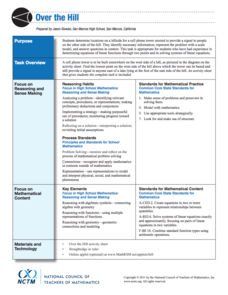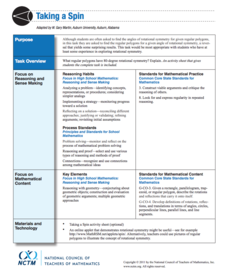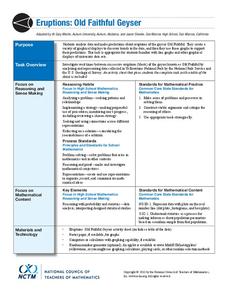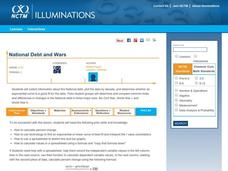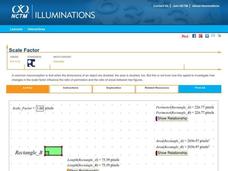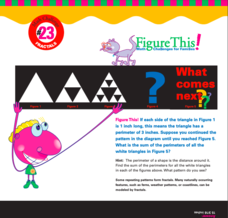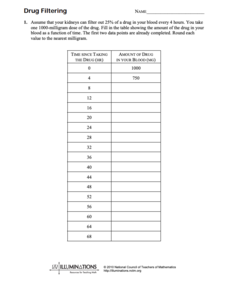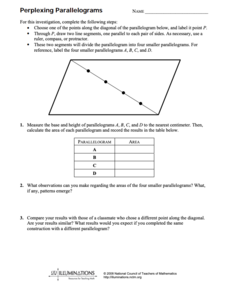National Council of Teachers of Mathematics
Stitching Quilts into Coordinate Geometry
Who knew quilting would be so mathematical? Introduce linear equations and graphing while working with the lines of pre-designed quilts. Use the parts of the design to calculate the slope of the linear segments. The project...
National Council of Teachers of Mathematics
Over the Hill
Can you hear me from there? Pupils determine the place to build a cell tower on a hill. The class uses constraints and creates a scale drawing on a coordinate system to calculate the exact location of the base of the cell tower.
National Council of Teachers of Mathematics
The Game of SKUNK
Do I stand or do I sit? The class plays a dice game where they must decide to either continue to stand and play or sit down and keep their points. After the game, groups discuss individuals' strategies and see connections to the...
National Council of Teachers of Mathematics
Cash or Gas?
Which option provides the best payout? Pupils predict which lottery prize to take. They devise a method to calculate which prize would likely provide the greatest monetary value.
National Council of Teachers of Mathematics
Bank Shot
Bank on geometry to line up the shot. The resource asks the class to determine the location to bank a cue ball in a game of billiards. Using their knowledge, class members determine where to hit the bumper to make a shot and discuss...
National Council of Teachers of Mathematics
Taking a Spin
It does not divide into 360 evenly, so it cannot work. The resource extends pupils' thinking about rotational symmetry. By asking for a figure with a rotational symmetry of a seemingly impossible angle, the activity requires learners to...
National Council of Teachers of Mathematics
Eruptions: Old Faithful Geyser
How long do we have to wait? Given several days of times between eruptions of Old Faithful, learners create a graphical representation for two days. Groups combine their data to determine an appropriate wait time between eruptions.
National Council of Teachers of Mathematics
Tidal Waves
Periodically ship the class a trigonometric application. Pupils model the level of water in a port. Using their models, learners determine the times that a ship can safely navigate into and out of the port, along with determining other...
National Council of Teachers of Mathematics
National Debt and Wars
Take a functional approach to the national debt. Learners collect information about the national debt by decade and plot the data. They determine whether an exponential curve is a good fit for the data by comparing the percent changes...
National Council of Teachers of Mathematics
Geogebra: Residuals and Linear Regression
If the line fits, use it. Using a Geogebra interactive, pupils plot points and try to find the best fit line. They assess the linear fit by analyzing residuals. A radio button allows participants to show the regression line and the...
National Council of Teachers of Mathematics
Scale Factor
Does doubling mean everything doubles? Learners adjust the scale factor between two rectangles. Using the calculated measurements, pupils investigate the ratios between the lengths, perimeters, and areas of the rectangles.
National Council of Teachers of Mathematics
Counting the Slope: Rise Over Run
This worksheet works math masters though the concept of rise over run. They shade in the slope triangle that is created to help visualize the components. After a page of teaching the concept is a thoughtful exercise to give to your class...
National Council of Teachers of Mathematics
Math Challenge #23: Fractals
Young scholars explore the concepts of Sierpinski's triangle, ratios, and concentrations. In this exploratory lesson, learners are given three problems to solve. Young scholars learn about Sierpinski's triangle, how to calculate mpg for...
National Council of Teachers of Mathematics
The Roll Out Fractions Game: Comparing Fractions
Reinforce the concept of comparing fractions with a hands-on, two-player game that calls for a visual model, score board, and dice. Players roll dice to acquire their given fraction, create the fraction using fraction tiles, then...
National Council of Teachers of Mathematics
Varying Motion
For this secondary mathematics learning exercise, high schoolers collect data based on a person’s motion. From this data, high schoolers create graphs comparing displacement, velocity, and acceleration to time. The five-page learning...
National Council of Teachers of Mathematics
Is It Fair?
In this probability instructional activity, learners answer nine questions about the fairness of games. Students determine if a game is fair or not. They list outcomes and find ones' chances of winning.
National Council of Teachers of Mathematics
Drug Filtering
In this chemistry instructional activity, learners calculate the amount of drug found in someones blood based on how long they have been taking the drug. There are 5 questions.
National Council of Teachers of Mathematics
Do I Have to Mow the Whole Thing?
In this mowing worksheet, learners find the area of given rectangles. They determine the combinations of lengths and widths that generate a given area. Learners graph given points. This two page worksheet contains sixteen multi-step...
National Council of Teachers of Mathematics
Improving Archimedes' Method
For this Archmides' method instructional activity, students determine the area of a regular n-gon inscribed in a circle. They use sine and cosine functions to solve problems. This three-page instructional activity contains 4...
National Council of Teachers of Mathematics
Seeing Music, Hearing Waves
In this music activity, 11th graders incorporate fractions into their music scales and counting scales. They listen to the music being played and relate it to sine waves reviewing the trig function. There are 11 questions involving sine...
National Council of Teachers of Mathematics
Perplexing Parallelograms
In this geometry worksheet, young mathematicians divide a parallelogram into four, by choosing points along a diagonal. Students calculate the area of each parallelogram and look for any patterns that may emerge. The one-page...
National Council of Teachers of Mathematics
Rough Rule
For this algebra activity, learners estimate the Canadian population using the rough rule. There are two questions.
National Council of Teachers of Mathematics
How Many Triangles?
For this triangles worksheet, learners problem solve and shade triangles within other triangles. Students complete two problems.
National Council of Teachers of Mathematics
Nctm: Illuminations: Bobbie Bear's Vacation Outfits
Help Bobbie Bear figure out how many outfits he could make with his shirts and pants. He can have up to 5 shirts and 4 pants. Figure out all the possible combinations.



